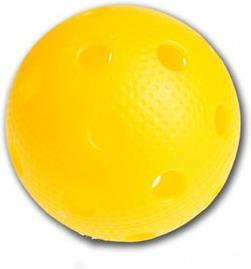

The season has begun - the great floorball basics
Autumn is coming, the leaves are changing colour and falling from the trees. A curse for many, but a blessing for some - like me, for example. Because autumn not only sees the start of new seasons of your favourite series, but also the floorball season. Uni-what, you ask? Let me explain.
As soon as it gets cooler, people are drawn to the warmth. Of course, it's logical and one of our many innate instincts. Some spend a rainy Sunday in front of a crackling fire, with a hot cup of tea and a warming pet, while others enjoy themselves in museums, cinemas or shopping centres. And then there are the floorball players.
English-speaking connoisseurs of the scene call it "floorball", Swedish and Norwegian nationals refer to it as "innebandy" and the Finns praise their "salibandy" stars to the skies. In German-speaking countries, it is called floorball. This comparatively young sport, which has now become the second most popular team sport in Switzerland, involves action, speed and heaps of goals. In other words, everything a sportsman's heart desires. I'll try to tell you why the floorball boom continues unabated - admittedly rather subjectively - from my own experience below.
The sport of the students
It is often wrongly claimed that floorball is a combination of the words university and hockey. This is also because the sport was initially only practised in schools (as it requires a gym). However, it is correct that it is an abbreviation of universal hockey. There are many smart alecks who claim to have invented this sport. However, floorball originated - how could it be otherwise - in the USA. In the 1950s, young people there played indoor hockey with plastic sticks and a plastic disc if the climatic conditions did not allow for outdoor sports activities.
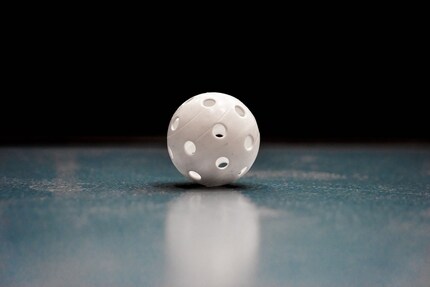
In the early seventies, Europe also got wind of it. However, the Europeans didn't enjoy the plastic disc very much and quickly turned it into a plastic ball, which they then covered with holes to make matters worse. The Swedes in particular, today's leading floorball nation, couldn't get enough of this new sport. There are now more than 4,000 clubs worldwide with well over 300,000 licensed players. In addition to Sweden, the Finns, the Czechs and we Swiss also have a say when it comes to crowning the world floorball champion. But exotic nations such as Singapore, Australia and South Korea are also registering a significant increase in the number of licenced players.
What do I need?
In addition to the "standard" sports outfit - i.e. shirt, shorts and trainers - you need a floorball stick, at least seven friends and a free gym. And, of course, a floorball. There are so-called right and left-handed sticks. Left-handed sticks are those where the blade, which is located at the bottom of the stick and is used to play, is used on the left of the player. The opposite is true for right-handed sticks. The majority of floorball players play on the left, but it is difficult to give a percentage - personally, I would estimate a ratio of 80% left to 20% right.
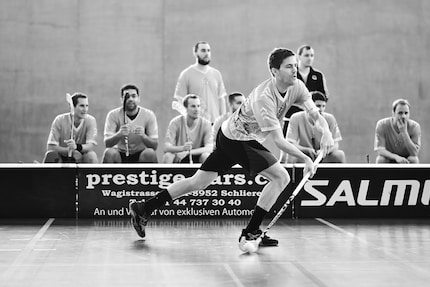
Sticks are available in different lengths because the players are different sizes - sounds obvious, and it's true. A rule of thumb is that the stick should reach below the navel. Of course, you can also fine-tune the length by trial and error. Nowadays, manufacturers offer almost any length. The material is usually carbon, and the colours cover the whole spectrum. Even partially curved poles are possible. You can also find the balls in all kinds of colours, but they always have 26 holes - the same number as Switzerland has cantons. Coincidence? I don't think so. The holes are intended to stabilise the trajectory and improve aerodynamics at the same time. Made of polyethylene - basically plastic - the little white ball not only causes painful marks all over the opponents' bodies, but also countless moments of happiness for your own team.
Balls
Sticks
Unihockey at Galaxus
You can find the entire Galaxus floorball range here.
As a goalkeeper, you don't need a stick as you mainly move on your knees. To avoid knee problems, you need knee pads. You also need to protect your shins, thighs, chest, arms and head. So you wear a helmet, lots of pads and male goalkeepers also wear a groin guard. Believe me, you really need it! Either the padding for the legs, arms and chest is already sewn into the goalkeeper's trousers and shirts, or it is worn directly on the body as additional waistcoats or pads - as is the case with all professional goalies, for example. Depending on the type of goalie, special gloves are also required, and there are even floorball goalkeeper boots on sale. That's quite a lot of equipment, you think? That's right. The goalkeeper also gets a lot.
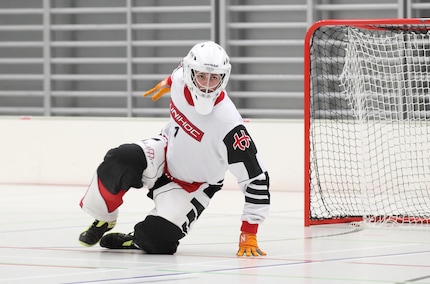
How the game is played
The floor hockey regulations are very comprehensive. I would therefore only like to go into the most important basic rules here. It's not meant to be a school lesson or lecture. By the way, I hope you have a successful start to the semester. So, back to the rules.
Field size, number of players and playing time
Unihockey is played on either a small or large pitch. The small pitch (14 by 24 metres) is roughly comparable to the size of a normal, small primary school sports hall. On the small pitch, there are three players and a goalkeeper on the pitch. Okay, the players stand, the goalkeeper kneels, sits or lies down. The game normally lasts twice for 20 minutes, with a five-minute break in between. The last three minutes of the game are played effectively, i.e. the clock is stopped every time the ball leaves the pitch, a goal is scored or a foul is whistled. In cup mode, by the way, 20 minutes are played three times - effectively, over the full distance.
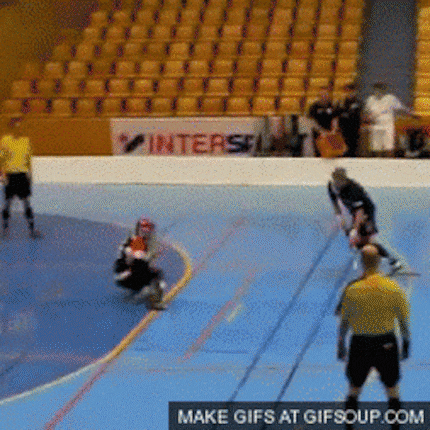
The large pitch (20 by 40 metres) only has space in a triple hall. Five players and a goalkeeper play on the large pitch. In contrast to the small pitch, the outfield players usually have their fixed positions here, such as defender, winger/forward or centre. Of course, fixed positions can also be played on the small pitch if teams are well-rehearsed - or if individual players have special skills. However, as the action takes place on a much smaller surface, it is often the case that every player has to be able to play all positions and stand in for their team-mates. Large pitch games last three times 20 minutes - in the lower leagues only the last three minutes are effective, in the upper leagues the entire duration of the game.
Leagues
There are now five leagues in Switzerland, both on the small and large pitches. As the large pitch enjoys a higher international reputation, the focus in the individual countries is also on this pitch size. This is why the top division on the large pitch in Switzerland is called National League A and the second division National League B. The numbering is then continued, i.e. the 3rd, 4th and finally the 5th league follow. In the minor leagues, the first league is also referred to as the first league, which continues down to the lowest 5th division.
Shortened set of rules
As already mentioned, there are hundreds of rules and guidelines. However, for reasons of time and, above all, space, I will only go into the most important "dos" and "donts" below. While four wooden benches in the corners of gyms often suffice to mark the boundaries of the pitch, officially standardised (and roughly knee-high) boards must be used in league matches. If the ball leaves the field during play, play continues with a free kick - also known as a free kick in football. Which side takes the free kick depends on which team was the last to touch the ball.
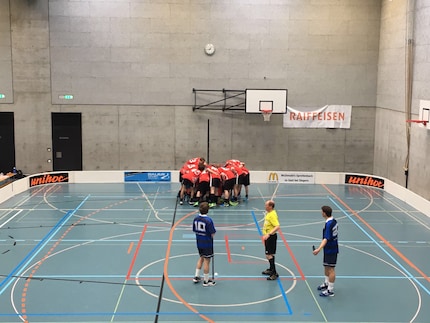
Stick strikes, lifting the stick or hard checks, such as in ice hockey, are prohibited in floorball. Depending on the severity of the offence, offenders are given a free kick or a two-, five- or even ten-minute time penalty. If a goal is scored (against the penalised team) while serving the time penalty, the field player may return to the field. Otherwise, the penalty must be served, even after the break. There is no offside, throw-in or corner kick in floorball. And the only person allowed to touch the ball with their hands is the goalkeeper. Or the referee, of course. Incidentally, at the whistle - or bully, as in ice hockey - the ball comes to rest while one player to the left and one to the right of it tries to use their stick shovel to manoeuvre the ball into their own ranks after the referee's whistle in order to prepare what will hopefully be the winning move.
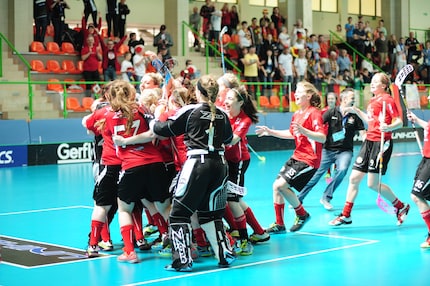
Sport, hobby and passion
When my mum dragged me to my first training session at the Urdorf Bulls floorball club at the tender age of ten, I had no idea that I would never let go of this sport. Twenty years later, I am not only an active player myself, but have also coached various junior teams - with (moderate) success. Fortunately, winning is only one side of the coin. Floorball also fascinates me because of the speed, the team spirit and the fact that after 40 minutes of play, five seconds can make the difference between winning and losing. For me, it's more than just a balance to work. It's more than just a hobby to meet colleagues and talk or make fun of things. It has become a passion and a part of me.
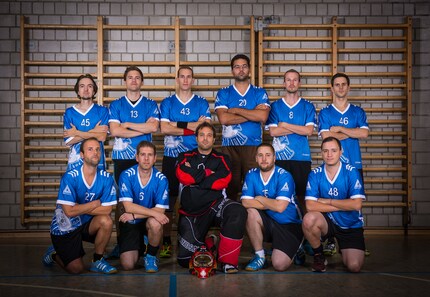
When I'm not stuffing my face with sweets, you'll catch me running around in the gym hall. I’m a passionate floorball player and coach. On rainy days, I tinker with my homebuilt PCs, robots or other gadgets. Music is always my trusted companion. I also enjoy tackling hilly terrain on my road bike and criss-crossing the country on my cross-country skis.
From the latest iPhone to the return of 80s fashion. The editorial team will help you make sense of it all.
Show all
